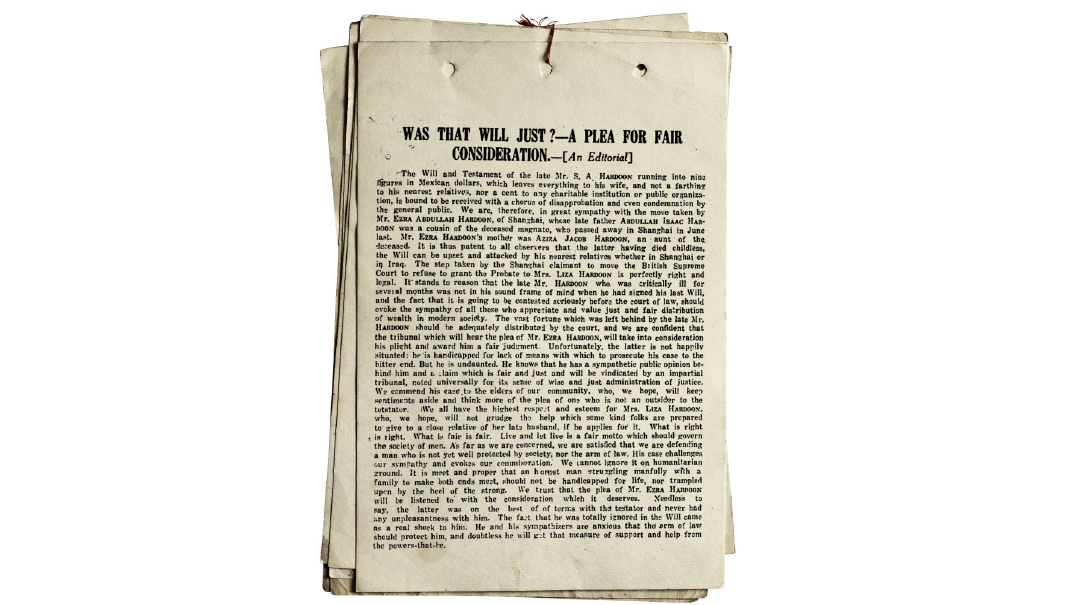A Lost Legacy
| April 21, 2021The shul and its builder had come full circle, attaining historic status while hosting the exiled yeshivah

Title: A Lost Legacy
Location: Shanghai
Document: Israel’s Messenger
Time: 1931
In the burgeoning free city of prewar Shanghai, there were few characters as perplexing as Silas Aaron Hardoon, an outsized figure whose real life story often blended with legend and mystique. Born in Iraq in 1851, he came to Shanghai as a young adult via India and began working for the illustrious Sassoon family. Before long he went out on his own and attained success in real estate. As Shanghai developed, he came to own much of what would become its downtown district, and by the mid 1920s he was the wealthiest man in all of Asia.
Hardoon assimilated and lived a life apart from the Jewish community in a grand estate replete with gardens modeled on Beijing’s iconic Summer Palace. Appeals to him for local Jewish charities were met with small or no response. Under the influence of his wife Liza, who was a devout Buddhist (and was rumored to have had a Jewish father), he became the patron of local Chinese educational and social causes. Childless, they adopted a dozen foreign children, some of whom had been abandoned by impoverished Jewish families when they fled the 1917 Bolshevik Revolution.
In the early 1920s, the Hardoons approached leaders of the Shanghai Jewish community with an offer to replace the Shearith Israel shul with a state-of-the-art synagogue. The new k’nis was to be named Beth Aharon in memory of Silas Hardoon’s father.
The community was shocked. Rumors spread that Hardoon’s father had appeared to him in a dream, rebuking him for having done nothing Jewish to honor his memory, and this was his way of paying tribute. A plot was chosen in the center of town on Museum Road, and the edifice was dedicated in 1927, with the Hardoons covering the land and building costs and handing the keys over to the community for stewardship.\
When Silas Hardoon passed away in the spring of 1931, he left instructions to have a proper Jewish burial. Arriving at the funeral, the local chevra kaddisha was dismayed to observe that Hardoon’s wife had engaged local Buddhist monks to hand out incense and engage in other foreign customs. Eventually the chevra kaddisha got their way and Hardoon received a proper Jewish burial, but the event became a local scandal, causing the president of the chevra kaddisha to hand in his resignation.
This was only the start of the saga, however. When Hardoon’s will was made public later that year, the community was shocked to hear that his entire estate had been left to his wife, with no charitable bequests whatsoever. Some speculated that Mrs. Hardoon had made changes to the document during the final days of her husband’s life. Family members from around the world (and some impostors pretending to be such) filed a series of lawsuits, fighting for a share of the funds, citing whatever Jewish and even Iraqi law might hold force in anarchic Shanghai. Ultimately the judge ruled in favor of Mrs. Hardoon, and she received the entire inheritance.
The story doesn't end here. In the fall of 1941, Mrs. Hardoon died, and the large majority of the Hardoon properties and fortune were requisitioned by municipal authorities. At the same time, the refugee Mir yeshivah was arriving in Shanghai. Since the Jewish population in that neighborhood was small, the community turned the Beth Aharon synagogue over to the yeshivah, which inhabited the facility until the end of 1944. The shul and its builder had come full circle, attaining historic status while hosting the exiled yeshivah, which would go on to help rebuild the Torah world after the war.
(Originally featured in Mishpacha, Issue 857)
Oops! We could not locate your form.












